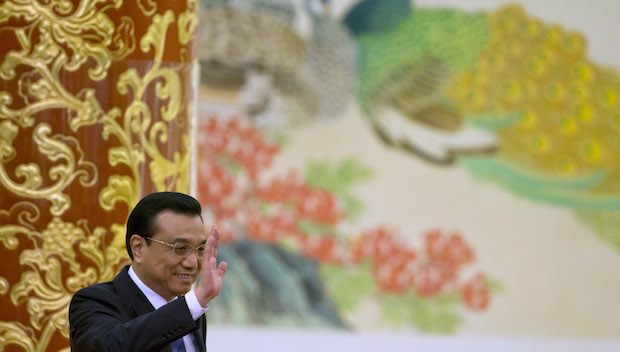
Chinese Premier Li Keqiang in Beijing’s Great Hall of the People, China, on March 13, 2014. (AP Photo/Ng Han Guan)
The Great Hall of the People was built in 1959 to commemorate the 10th anniversary of the founding of the People’s Republic of China. Then-US President Richard Nixon dined in its banquet hall during his historic visit to the country in 1972. This week, the Great Hall hosted a welcome ceremony for Crown Prince Salman Bin Abdulaziz; the setting underscores the symbolism of the Crown Prince’s visit to China. This is the year when the Asian giant is set to become the largest oil importer in the world, as well as the largest export market for Saudi oil. Energy is the main driver of an ever-closer Saudi–Sino relationship, which now also boasts growing investment, trade and people-to-people ties.
Beijing and Riyadh only established diplomatic relations in 1990, yet a fundamental development in China only three years later promptly highlighted the potential for strong bilateral ties. In 1993, China became a net oil importer. Saudi Arabia quickly developed into its largest source of oil, covering 19 percent of all Chinese oil imports by 2013. Even though recent Chinese customs data suggests that Beijing is trying to diversify its sources by increasing imports from countries such as Iraq and Oman, Saudi Arabia has two advantages over other suppliers: it is stable, and Saudi–Sino relations now go beyond the oil sector. Thus, it is very likely that Saudi Arabia will remain China’s largest oil source for years to come.
Indeed, Riyadh also has powerful incentives to consolidate its exports to the Asian giant. For once, China is the second-largest destination of Saudi oil, accounting for 14 percent of its exports in 2012. With the ongoing fracking revolution in the United States and subdued economic growth in the European Union and Japan, China is set to develop into an even more important destination for Saudi oil. Becoming its largest export market this year would only draw further attention to the energy ties between the two countries.
President Xi Jinping and Crown Prince Salman called for broader cooperation during this week’s meeting in Beijing. They recognize both the already multifaceted nature of bilateral links and the potential to build on existing relations to further deepen them.
Investment is the area in which Saudi—Sino ties are strongest and also hold greatest potential. Data from the UN Conference on Trade and Development shows that China is the largest Asian source of Saudi Arabia’s inward foreign direct investment (FDI), as well as the biggest destination of Saudi investment in the continent. FDI is dominated by state-owned companies such as Aramco and Sinopec investing in refineries in each other’s countries. Landmark projects in this area include the Fujian and Yanbu complexes.
Bilateral investment links run deeper though. Aramco and Sinopec also have a gas exploration joint venture, and the Chinese company’s first-ever international downstream investment involved its Saudi partner. Beyond the energy sector, Chinese companies have been busy investing in multi-billion-dollar infrastructure and industry projects in the Gulf country. This trend is set to increase. Both Beijing and Riyadh sit on large cash piles ready for investment. Furthermore, both governments have recently started investor-friendly reforms in a bid to attract more FDI. There now seems to be an air of inevitability behind Saudi–Sino investment flows.
Similarly, bilateral trade volumes have grown and become more diversified. Trade between the two countries reached 73 billion US dollars in 2012, increasing by 14 percent from the previous year. China is Saudi Arabia’s second-largest trading partner, only behind the US. While Saudi Arabia is not one of China’s largest trading partners, the Gulf kingdom is its most important export destination in the region. Rising demand for cheap Chinese goods and other, more expensive products such as Geely cars are helping drive the growth in trade. This trend is likely to continue as Chinese companies seek to increase their market share in the Gulf and Saudi consumers become more knowledgeable about Chinese products. Were a proposed Sino–GCC Free Trade Agreement to be signed, trade would receive another boost. There is hope that Crown Prince Salman’s meeting with President Xi will help in this respect.
Growing people-to-people links underpin an increasingly market-oriented relationship. Students and businesspeople are travelling in both directions in growing numbers. Most notably, it is becoming de rigueur for young Chinese people to spend some time at a Gulf institution in order to crack the oil sector. No country has benefited more from this trend than Saudi Arabia, with King Abdullah University of Science and Technology welcoming increasing numbers of Chinese students. While the approximately 400 Chinese students in Saudi Arabia and 1,300 Saudi students in China seem like a drop in the ocean, it is their quality that matters. Most of them are highly qualified young people who most probably will be key to maintaining and expanding bilateral energy, trade and investment flows between both countries for years to come. Beijing’s Great Hall of the People could soon have to make room for more Saudi visitors.
